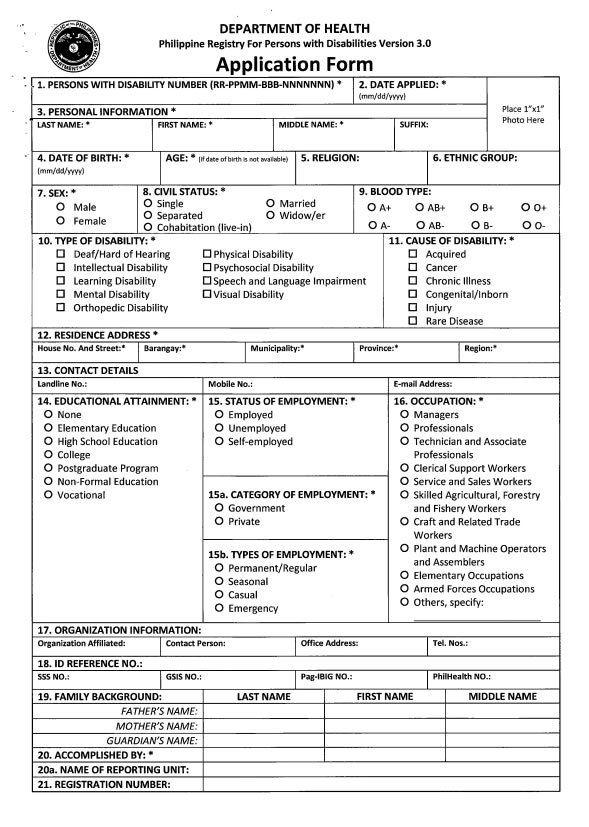Republic of the Philippines
Department of Health
OFFICE OF THE SECRETARY
ADMINISTRATIVE ORDER
No. 2013 -0005-A
NOV O 6 2019
SUBJECT: Amendment to Administrative Order No. 2013-0005 dated February 7, 2013 entitled “National Policy on the Unified Registry Systems of the Department of Health (Chronic NonCommunicable Diseases, Injury Related Cases, Persons withDisabilities and Violence Against Women and Children Registry System)”
- Rationale:
The United Nation – Convention on the Rights of Persons with Disabilities (UN CRPD) member states must undertake to collect appropriate information, including statistical and research data to formulate and implement policies to give effect to the present Convention. While Incheon Strategy aims “to make the Rights real for PWD in Asia and the Pacific, goal #8 focused in improving the reliability and comparability of disability data and thereby producing and disseminating reliable and internationally comparable disability statistics in formats that are accessible by PWDs.
Implementing Rules and Regulations of Republic Act (RA) 7277 otherwise known as the “Magna Carta for Disabled Persons” stipulates that the Department of Health (DOH) shall set-up a national registration/reporting for specific types of disabilities and shall generate and assess database on the current status, needs and circumstances of persons with disabilities in the country to provide an effective basis of a national health program plan for persons with disabilities.
Further, Rule IV, Section 4, Paragraph B of the Implementing Rules and Regulations (IRR) of the same Act, required the Department of Health-National Health Program for Disability to address the health promotion, prevention, early detection and rehabilitation of disabilities/conditions such as but not limited to the following: (1) orthopedic/moving disabilities, (2) communication deficits, (3) visual/seeing disabilities,
(4) learning (cognitive or intellectual) disabilities, (5) chronic illnesses with disability, (6) mental disabilities, and (7) psychosocial and behavioral.
Hence, the DOH issued an Administrative Order (AO) No. 2013-0005, “National Policy on the Unified Registry Systems of the Department of Health” (Chronic Non-Communicable Diseases, Injury Related Cases, Persons with Disabilities, and Violence Against Women and Children Registry System)” which states that the Philippine Registry for Persons with Disabilities (PRPWD) as a component of this issuance make certain that a recording and reporting system of different types of disabilities shall be established and institutionalized at the national, regional and local levels. With this, the DOH worked with the National Council on Disability Affairs to make necessary improvements on the PRPWD.
II. Objectives:
- To provide a revised/modified version of the DOH PRPWD
- Harmonize the registry with RA 11228, RA 10747 and RA
III. Coverage and Scope
This Order shall apply to all DOH Central Office, Centers for Health Development Offices, Philippine Health Insurance Corporation, Provincial/District/ City/Municipality Offices, government and private clinics/hospitals/offices, medical professional societies/associations, and related health care establishments, pharmacies and other establishment dispensing medicines.
IV. Definition of Terms
Consistent with the pertinent definitions used in the Implementing Rules and Regulations of RA 7277 and RA 9442 and World Health Organization, the following terms shall be defined as follows:
- Chronic illness – describes a group of health conditions that last a long It may get slowly worse over time or may become permanent or may lead to death. It may cause permanent change to the body and will certainly affect the person’s quality of life. This is also true to persons diagnose with Cancer or Rare Disease. Thus, Chronic illnesses may cause disability, hence, it is considered not a disability.
- Deaf/Hard of Hearing – refers to people with hearing loss, implies little or no hearing/ranging from mild to severe. Hearing loss, also known as hearing impairment means the complete or partial loss of the ability to hear from one or both ears with 26 dB or greater hearing threshold, averaged at frequencies 0.5, 1, 2, 4 kilohertz.
- Impairment is any loss, diminution or aberration of psychological, physiological, or anatomical structure or function.
- Intellectual Disability – a significantly reduced ability to understand new or complex information and to learn and apply new skills.
- Learning Disability – persons who, although normal in sensory, emotional and intellectual abilities, exhibit disorders in perception, listening, thinking, reading, writing, spelling, and arithmetic.
- Mental Disability – disability resulting from organic brain syndrome (i.e. Mental retardation, acquired lesions of the central nervous system).
- Orthopedic disability – disability in the normal functioning of the joints, muscles, and limbs.
- Persons with disabilities include those who have long-term physical, mental, intellectual or sensory impairments which in interaction with various barriers may hinder their full and effective participation in society on an equal basis with others.
- Physical Disability – any impairment which limit the function of limbs or fine or gross motor ability.
- Psychosocial Disability – any acquired behavioral, cognitive, emotional or social impairment that limits one or more activities necessary to effective interpersonal transactions and other civilizing process or activities to daily living such as but not limited to deviancy or anti-social
- Speech and Language Impairments mean one or more speech/language disorders of voice, articulation, rhythm and/or the receptive and expressive processes of language.
- Visual Disability – A person with visual disability (Impairment) is one who has impairment of visual functioning even after treatment and/or standard refractive correction, and has visual acuity in the better eye of less than (6/18 for low vision and 3/60 for blind), or a visual field of less than 10 degrees from the point of fixation. A certain level of visual impairment is defined as legal blindness. One is legally blind when your best corrected central visual acuity in your better eye is 6/60 on worse or your side vision is 20 degrees or less in the better eye.
V. Declaration of Policies
RA 11228, s. 2019 An Act Providing for the Mandatory PhilHealth Coverage for All Persons with Disabilities, amending for the Purpose, Republic Act No. 7277, otherwise known as the Magna Carta for Persons with Disabilities.
- RA 11215, s. 2019, An Act Institutionalizing a National Integrated Cancer Control Program and Appropriating Funds Therefore.
- RA 10747, s. 2016, An Act Promulgating a Comprehensive Policy in Addressing the Needs of Persons with Rare Disease
VI. General Guidelines
- The Disease Prevention and Control Bureau (DPCB) and Knowledge Management and Information Technology Service (KMITS) revised and simplified the PRPWD Application Form (Version 3.0, Annex A). It will replace the PRPWD Version 2.0 (Annex B) in the uniform resource locator (URL)/website: doh.gov.ph.
- The PRPWD Version 3.0 aside from featuring the enhanced application form shall implement stricter security measures in user account management (i.e. registration of system users, password expiration, etc.) in compliance to RA 10173 or The Data Privacy Act of 2012. Accordingly, attached is a users’ guide highlighting the major modifications in the system (Annex C).
VII. Repealing Clause
Administrative Order (AO) No. 2013-0005 is hereby modified by this Order., other provisions not affected still stands in effect. All other policies or issuances inconsistent or contrary to the provisions of this AO is hereby revised or modified accordingly.
VIII. Effectivity
This Order shall take effect immediately after its publication in two (2) newspaper of general circulation.
FRANCISCO T. DUQUE, III, MD, MSc
Secretary of Health



